#Zarina Hashmi
Text

Zarina Hashmi, The Ten Thousand Things IV, (detail), (set of 100 collages mounted on Somerset white paper), 2018 [Luhring Augustine, New York, NY. © Zarina Hashmi]

185 notes
·
View notes
Photo

Zarina Hashmi - Weaving Memory, 2006. Cut and woodblock print and text, 101,6 x 104 cm. x
22 notes
·
View notes
Text

Admission to many museums in the UK are free, so once and a while we drop in to get to see local art. Here are some photos of art with themes of colonization, injustice, and issues of our time at Tate Liverpool.

This photo is of a Palestinian woman in what’s left of her home during the Sabra Camp massacre in 1982. It is by Don McCullin, a British photographer who covered the Lebanese Civil War during his visits in 1976 and 1982. Palestinian refugees fled to Lebanon after the establishment of Israel in 1948 in what was once a part of Palestine. The war in Lebanon led to massacres of Muslim neighborhoods including Palestinians in the Sabra refugee camp.
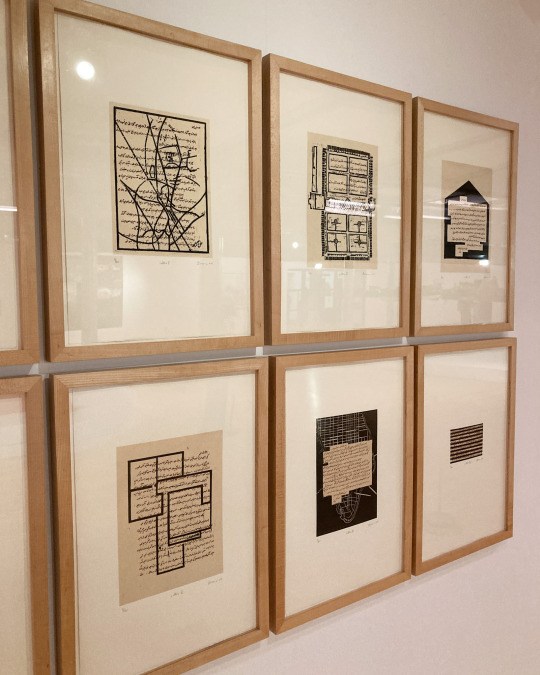
The late Zarina Hashmi was an Indian-American artist born in India, whose family was displaced by the 1947 partition of India after British colonial rule. While her sister Rani moved to Pakistan, Zarina eventually traveled the world, staying in touch with her sister everywhere she went. “Letters from Home” use these letters from Rani as a basis for the art, as they are written in Urdu and printed along with depictions of blue prints and maps of the places Zarina had lived through the years.
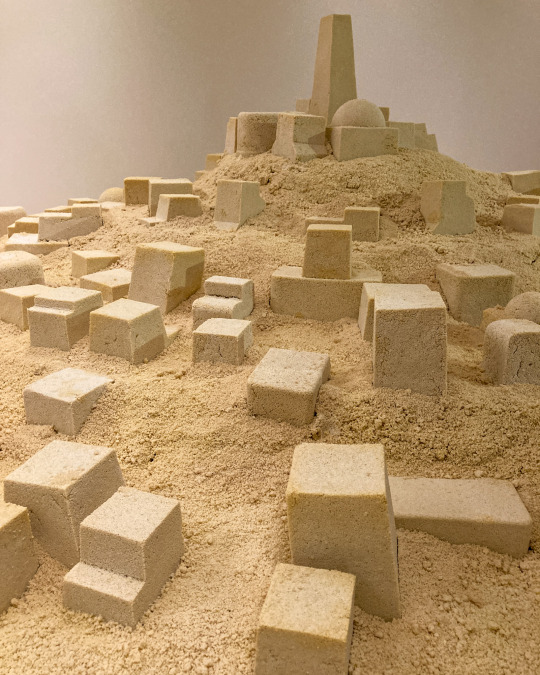
Kader Attia was born in France to Algerian parents, and later grew up in Algeria. Believe it or not, this artwork is made out of food. Specifically, couscous, a staple in Algeria as well as the rest of North Africa. Near the exhibit is a photo of Swiss-French architect Le Corbusier, who applied modernist architecture during the French colonial period in Algeria near the mid 1900s. In this artwork Attia seems to shape buildings in the modernist style, depicting the ancient hilltop city of Ghardaia in Algeria. The buildings are molded in couscous, and cracks and crumbling areas in the buildings could be seen as weathering from both the city’s old age and French colonization.

Torkwase Dyson handcrafted these huge, black structures and placed them in a large dark space on the first floor of Tate Liverpool. Dyson’s abstract works “grapple with the ways in which space is perceived, imagined and negotiated particularly by black and brown bodies.” This installation, “Liquid a Place,” definitely displays this, with these huge statues of what seam like heavy slabs of the darkest marble. They definitely convey the weight of colonization for me, and the artist description of them echoing “the curve of a ship’s hull” got me the most. Tate Liverpool sits in what was once one of Europe’s busiest ports serving the Transatlantic Slave Trade.

Lubaina Himid was one of the pioneers of the UK’s Black Art movement in the 1980s. “Carrot Piece” shows a white figure hovering a carrot over a Black woman carrying her own plentiful batch of food and items. The white figure is on a unicycle and wears light make up, conveying ridiculousness or crude entertainment, as if a clown. These are cut-out wooden paintings that are life-sized and was made for, as Himid wrote in her description, “…the moment when you slowly realise that you have learned something quite useful about yourself which proves to be a whole lot better than anything ever offered to you for free.”

Kerry James Marshall is known for his colorful paintings depicting Black people in dark shades. He counters “Western pictorial tradition” and brings forward Black figures in it. This work shows a Black figure wearing a British royal guard uniform, holding a sandwich board advertising a fish and chips restaurant named after a freedman, prominent writer, and British slavery abolitionist Olaudah Equiano. The irony of this art, is that it does not show a place in England. It is a scene in Arizona, where a “London Bridge” was made to attract American tourism.
#Tate Liverpool#Kerry James Marshall#Zarina Hashmi#Don McCullin#Lubaina Himid#Kader Attia#Torkwase Dyson
4 notes
·
View notes
Text





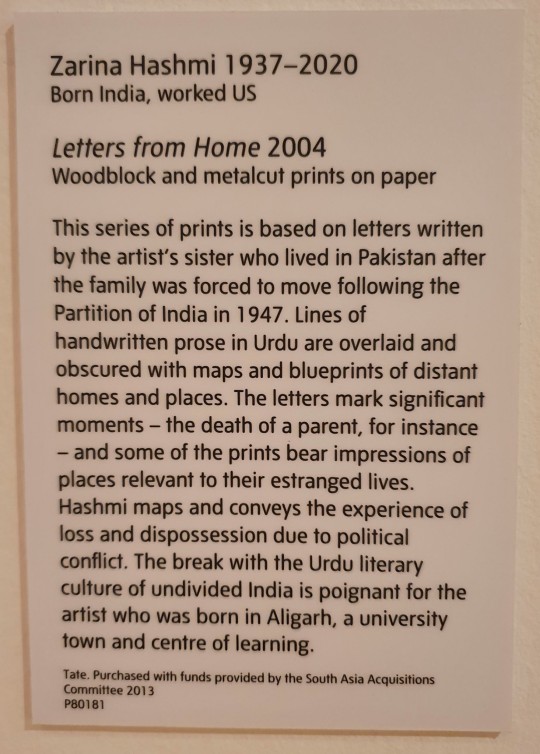
Zarina Hashmi, Letters from Home (2004)
#ameera speaks#art#zarina hashmi#undescribed#sorry for the photo glare i took pictures to send to my mum for her to translate for me hehe
49 notes
·
View notes
Text
Indian-American artist Zarina Hashmi
Zarina Hashmi (1937-2020) was an Indian American artist and printmaker known for her minimalist works that explore themes of home, displacement, and borders. Her work is often characterized by its use of simple geometric forms and its focus on materiality.
zarina hashmi was born in Aligarh, India, in 1937. She studied mathematics at Aligarh Muslim University, but her interest in art led her to pursue a career in printmaking. She studied woodblock printing in Bangkok and Tokyo, and intaglio with S. W. Hayter at Atelier 17 in Paris.
zarina hashmi work is deeply influenced by her personal experiences. In 1958, she married an Indian diplomat and moved to Bangkok. She spent the next several years traveling the world with her husband, and these experiences had a profound impact on zarina hashmi art.
Hashmi's work often explores themes of home, displacement, and borders. She was particularly interested in the impact of partition on India and Pakistan, and her work often reflects on the loss and displacement that resulted from this event.

Hashmi's work is also characterized by its use of simple geometric forms and its focus on materiality. She often used paper, wood, and metal in her work, and she was interested in the ways in which these materials could be manipulated to create different textures and effects.
Hashmi's work has been exhibited in museums and galleries around the world, including the Museum of Modern Art in New York City, the Tate Modern in London, and the National Gallery of Modern Art in New Delhi. She has also received numerous awards for her work, including the Padma Bhushan, India's third-highest civilian honor.
Zarina Hashmi prints for sale
Zarina Hashmi prints are zarina available for sale from a variety of galleries and auction houses. Some of the most popular online marketplaces for Zarina Hashmi prints include:
Artsy
Saatchi Art
1stDibs
Invaluable
MutualArt
Zarina Hashmi Letters from Home
Letters from Home is a series of woodblock and metalcut prints that Zarina Hashmi created in 2004. The series consists of 24 prints, each of which depicts a letter from Hashmi's mother to her. The prints are inscribed with Urdu words and phrases, and they evoke a sense of longing and nostalgia for home.
The Letters from Home series is one of Hashmi's most popular and critically acclaimed works. It has been exhibited in museums and galleries around the world, and it is included in the collections of many major museums, including the Metropolitan Museum of Art in New York City and the Tate Modern in London.
Zarina Hashmi death
Hashmi died on January 10, 2020, at the age of 82.
#zarina hashmi#zarina hashmi artwork#zarina hashmi letters from home#zarina hashmi death#zarina hashmi prints for sale#artist#artwork
0 notes
Text

Zarina Hashmi's artistic odyssey demonstrates the ability of creativity to transcend boundaries and unite people across cultures. Her art continues to inspire and connect with new audiences, fostering a deeper appreciation for abstraction, minimalism, and the exploration of identity. Through platforms like Auction Daily, her work reaches a broader audience, promoting the beauty of these artistic expressions.
1 note
·
View note
Text
Zarina Hashmi (1937-2020), one of India's greatest artists, is discussed by curator Sheena Wagstaff.
0 notes
Text
Zarina Hashmi: The Pioneering Artist Whose Work Transcends Borders P-57
Zarina Hashmi: The Pioneering Artist Whose Work Transcends Borders
Zarina Hashmi (née Rashid; 16 July 1937 – 25 April 2020), known professionally as Zarina, was an Indian American artist and printmaker based in New York City. Her work spanned drawing, printmaking, and sculpture, and she was closely associated with the minimalist movement. With abstract and geometric forms, Zarina aimed to evoke…

View On WordPress
#Indian American artist#Who was Zarina Hashmi#Zarina Hashmi#Zarina Hashmi Delhi#Zarina Hashmi on trend
0 notes
Text

Zarina Hashmi, The Ten Thousand Things IV, (detail), (set of 100 collages mounted on Somerset white paper), 2018 [Luhring Augustine, New York, NY. © Zarina Hashmi]

87 notes
·
View notes
Photo
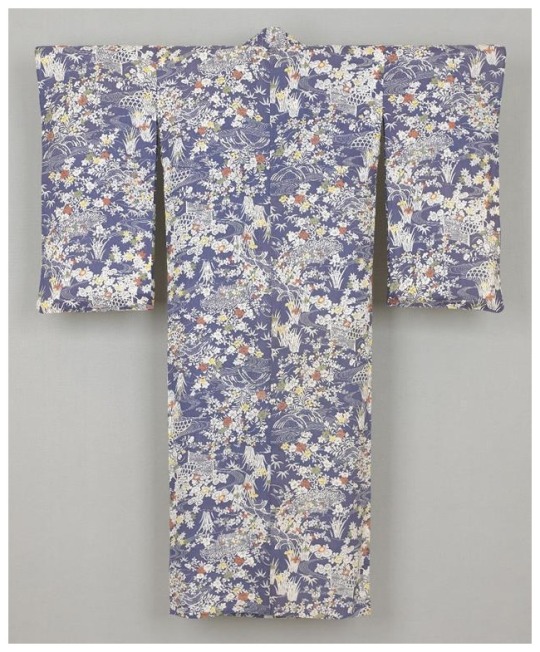

Kimono. Late 19th - early 20th century /Japanese/ Asa cloth with indigo dye (katazome), 58 3/4 x 47 in. (149.23 x 119.38 cm)
This summer kimono is replete with floral and foliage motifs-irises, chrysanthemums, maples, clover-and bamboo baskets set amidst streams of water. Highly detailed and colorful, the composition on textured hemp creates a stylized visual image of the summer and autumn seasons. In addition to the indigo dye stenciled on the main body of the garment, the areas of yellow, orange, and green colors also feature the katazome (stencil) technique, and work effectively to set each other off well.
Seattle Art Museum
Zarina Hashmi (1937-2020) - Untitled, 1968. Oil on canvas / 54 x 71 cm. x
7 notes
·
View notes
Text
THE BEST ZARINA HASHMI BIOGRAPHY REVIEWED ON 86TH BIRTHDAY

Google has honored Zarina Hashmi on her 86th birthday by creating a doodle related to her work and her significant contribution. Zarina Hashmi was a highly respected and accomplished artist who made significant contributions to the field of contemporary art.
Her work often explored themes of displacement, memory, and identity, and she was known for her ability to distill complex experiences into simple forms. Zarina died in London on 25 April 2020 from complications of Alzheimer’s disease.
Hashmi’s work has received critical acclaim throughout his career and has been displayed in galleries and museums around the world. In 2011, she was awarded the prestigious Joan Mitchell Foundation Grant for her contribution to contemporary art.
Despite his success, Hashmi has always remained humble and devoted to his craft.His work continues to inspire and challenge audiences. invites them to reflect on the complexities of identity and belonging in an increasingly globalized world.
About
Zarina Hashmi (1937–2020) was a renowned Indian-American artist known for her complex and minimalist works, which explored themes of migration, displacement and identity.
She was a distinguished and accomplished artist who led a life dedicated to her artistic pursuits. She continued to create art until her passing in 2020.
She was born on 16 July 1937 in a middle-class Muslim family in Aligarh, India.
Her father, Sheikh Ghulam Hashmi, was a mathematics professor at Aligarh Muslim University, and her mother, Nazneen Begum, was a homemaker. After the partition of India in 1947, she moved to Pakistan.
Zarina Hashmi was married to Indian artist Iqbal Jeffrey and has no children.
Education
Zarina Hashmi’s early education started in India and she studied Mathematics at Aligarh Muslim University. It was during her studies that she developed an interest in printmaking (graphic design) and later she moved to Bangkok, Thailand from where she studied printmaking at the Bangkok Art Institute.
In the early 1960s, Zarina moved to Paris, France, where she continued her artistic education at the École des Beaux-Arts and Atelier 17.
She began creating prints, drawings, and sculptures that reflected her personal sense of displacement and cultural identity. Used to find out experiences.
His work often featured maps, grids, and geometric shapes, reflecting his interest in mathematics and cartography. He also incorporated text and calligraphy into his works, drawing inspiration from his Muslim faith and the Urdu language, and explored themes of displacement and identity. topics explored.
Career
After returning to India in the 1970s, Hashmi began working as a printmaker at Garhi Studio in Delhi, and began to incorporate calligraphy into his works.
After moving to the United States in 1976, Zarina continued to create art exploring themes of displacement, memory, and identity.
Her work often consisted of geometric shapes, calligraphy and maps, and was deeply influenced by her experiences as a South Asian woman living in a foreign country.
During his time in America, Hashmi exhibited his work widely, including at the Venice Biennale, the Guggenheim Museum in New York, and the Whitney Museum of American Art.
He also held several teaching positions at institutions such as the University of California, San Diego, and the University of Pennsylvania.
The most famous of Hashmi’s works in America is “The Dividing Line”, a series of prints that trace the partition of India and Pakistan. and “Home is a Foreign Place”, a series of prints that reflect this idea of home and belonging.
While on the editorial board of the feminist arts magazine Heresies, Hashmi also contributed heavily to the “Women of the Third World” issue.
She has lived and worked in various cities around the world, including Bangkok, Tokyo, Paris, and New York.
She has exhibited her work internationally, including at the Venice Biennale, the Guggenheim Museum in New York, the Whitney Museum of American Art, and the British Museum.
Her work has also been exhibited internationally at major museums and galleries, including:
Venice Biennale (2011)
Guggenheim Museum in New York (2014)
Whitney Museum of American Art in New York
British Museum in London
Museum of Modern Art in New York
Art Institute of Chicago.
Guggenheim Museum, New York
Zarina Hashmi had an important role in the Guggenheim Museum in New York. In 2014, the museum organized a retrospective of her work titled “Zarina: Paper Like Skin”, showcasing her minimalist and abstract works that explored themes of displacement, memory and identity.
The exhibition featured more than 60 of Hashmi’s works, including prints, drawings, sculptures, and installations. The exhibition was curated by Sandhini Poddar and was the first major retrospective of Hashmi’s work in the United States.
In addition to retrospectives, Hashemi’s work is also housed in the permanent collection of the Guggenheim Museum, which includes many of his prints and sculptures.
Zarina Hashmi’s Books
Zarina: Paper Like Skin (2012) by Allegra Pesanti and Sandhini Poddar
Zarina: Her Life, Her Art by Pranabaranjan Ray (2004)
Zarina Hashmi: by Deepak Ananth and Grant Watson Edited Critical Dialogues (2017)
Zarina: Weaving Memory by Avik Sen (2016)
Zarina: Atlas of My World by Boon Hui Tan (2012)
These books provide insight into Hashmi’s artistic practice, her life experiences, and wider cultural and historical contexts. in which his work was created.
Zarina Hashmi “Atlas of My World”
Atlas of My World is a book by Zarina Hashmi which was published in 2012. The book is a collection of prints, drawings and photographs that reflect the themes of memory, displacement and identity that are central to his work.
The book includes reproductions of some of Hashmi’s most iconic works, including her “Home is a Foreign Place” series, which consists of abstract maps that explore the idea of home and belonging. It also includes personal photographs and sketches that provide insight into his creative process and life experiences.
In addition to the images, the book also includes essays from art historians and curators that provide context for Hashemi’s work and explore its importance in the wider field of contemporary art. Overall, “Atlas of My World” is a rich and insightful exploration of the life and work of one of the most important artists of our time.
Zarina Hashmi “The Way to My House”
“Directions to My House” is a print series by Zarina Hashmi that was created in 1999. The series consists of 36 prints, each containing a simple map or diagram that provides directions to the artist’s home in New York City.
The prints are created using traditional techniques such as woodblock printing and letterpress, and they incorporate elements from calligraphy and other forms of text-based art. The maps themselves are intentionally simplified and abstract, including only the most essential details.
Through this series, Hashmi explores the idea of home and belonging and the ways in which we create a sense of place in an increasingly complex and globalized world. The series has been screened internationally and is considered one of his most important works.
Zarina Hashmi “Letters from Home”
“Letters from Home” is a series of works by Zarina Hashmi that includes prints and sculptures. The series is based on the letters Hashmi received from his family in India while living abroad. The letters were a way for Hashmi to stay connected to her home and family, and her work explores themes of memory, displacement and longing.
The prints in the series include maps, diagrams, and text that refer to the letters, while the sculptures are made of materials such as paper, wood, and metal. “Letters from Home” is considered one of Hashemi’s most important works and has been displayed in museums and galleries around the world.
Awards and Achievements
Zarina Hashmi has received numerous awards and honors throughout her career, including:
President’s Award for Printmaking in India (1969)
Grand Prize Awards Bhopal, India (1989)
Scowhegan Medal for Sculpture (1991)
Lifetime Achievement Award (2004) for Art
Pakistan’s Highest Civilian Award for Art, Sitara-e-Imtiaz (2011)
Zarina Hashmi Quotes
Here are some notable quotes from Zarina Hashmi
Zarina Hashmi says she is interested in boundaries because she has seen what happens when they are broken.”
“Zarina feels the process of making art is a process of discovery”.
"She finds the idea of home interested, and what it means to belong to a place.”
“He has always been interested in the idea of memory, and how it shapes our sense of self.”
“For me, art communicates with the world It’s a way of doing. It’s a way of expressing my thoughts and feelings about the things that matter to me.”
"These quotes reflect Hashmi’s interest in themes such as boundaries, memory, identity and belonging, and her belief in the power of art as a means of communication and self-expression."
0 notes
Text
Zarina Hashmi's Google Doodle: A Tribute to Master of Minimalist Art
Google Doodle has joined the world to celebrate today, the incredible legacy of Zarina Hashmi, the pioneering Indian American artist whose indomitable spirit and profound creativity have left an indelible mark on the art world. On what would have been her 86th birthday, Google Doodle pays tribute to her influential artistic journey, designed by the talented illustrator Tara Anand from New York,…
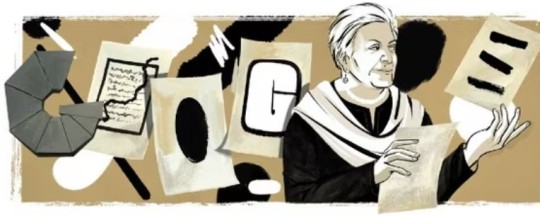
View On WordPress
0 notes


